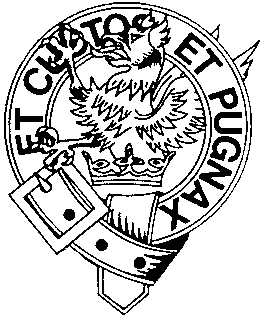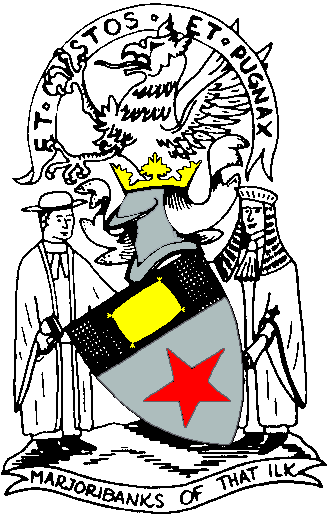
|
Marjoribankses on the Net Clan Marjoribanks Discussion Area Clan Marjoribanks Contacts |

|
Marjoribankses on the Net Clan Marjoribanks Discussion Area Clan Marjoribanks Contacts |

In recent times, however, some doubt has been raised about this explanation, for several reasons. Professor A.A.M. Duncan of the University of Glasgow, says flatly that his perusal of ancient records indicates that "the marriage portion of Walter Stewart certainly did not include lands in Dumfries- shire."
The farmstead in the parish of Kirkpatrick-Juxta, just south of Moffat, which is recognized as the ancestral lands, was known as Marjoribanks (sometimes Merioribankis or other variations) from the Middle Ages and up until the beginning of the 18th century. It is now called Marchbank Farm.
If the lands traditionally associated with the family were not in fact part of Lady Marjorie's dowry, how did they come to be called Marjoribanks? There are a number of interesting speculations.
One explanation, which Professor Derick S. Thomson of the University of Glasgow finds "very plausible," is that some tenants of the Bruce family, who were considerable land-holders in Annandale in the 13th and 14th centuries, simply changed the name of their lands to Marjoribanks to honour Lady Marjorie and perhaps to shine in her reflected fame.
This theory is supported by the fact that most place names were already established before the time of Lady Marjorie's marriage in 1315. Furthermore, an estate as small as the "five-merkland" farm, (i.e. a parcel of land that would rent for five merks or £3/6/8 in Scots money) is unlikely to have been distinguished with such a name.
It is also possible, of course, that the name was simply invented by a
medieval clerk who didn't hear correctly what he was told to write, or
made a mistake in copying the name from another document. If the
family name was originally Marchbanks, Professor Thomson suggests
that the first element may have been the Welsh word "march," meaning
a horse, since Welsh was widely spoken throughout southern Scotland
in the early Christian centuries.

In any case, the idea that the Marjoribanks lands were part of Lady Marjorie's dowry cannot be reliably traced for more than a couple of centuries. The story may have been devised by Joseph Marjoribanks who obtained his own grant of arms from the Lord Lyon in 1673 and established a junior branch of the family. Certainly the association with Lady Marjorie would have some appeal to Joseph, whose forbears for several generations had been bourgeois traders and burgesses of Edinburgh. A century or so later, a scion of the family who was steward to the Marquis of Bute before attaining greater distinction, presented the marquis with a volume detailing his family history including the traditional account of the origin of the name. Unfortunately, this volume seem to be no longer extant.
However the five-merk lands in Dumfriesshire may have come be called Marjoribanks, there is no doubt that it is from these lands that the modern family takes its name. A charter of 1529, which roughly delineates the boundaries of the ancestral lands, clearly places its centre at about the modern farm of Marchbank.
There is a hamlet called Marjoriebanks just north of Lochmaben, some 10 miles to the south of the lands described in the charter. It was called Bogle Hole in 1828 and there is clear evidence that the place-name Marjoriebanks was unknown in Lochmaben before the middle of the 19th century. The community may possibly have been named in honour of Rev. Thomas Marjoribanks of that Ilk who was minister of Lochmaben parish church from 1834 to 1850, and whose name is consistently spelled in church records with an additional 'e'.
The question as to whether all Marjoribankses were originally Johnstones remains unsolved. The original Marjoribanks lands in Annandale were sold in the 1630s to Samuel Johnstone of Scheyns who, in 1634, sold them to his Chief, James, Lord Johnstone. Subsequent occupants of the lands, according to tradition, may have adopted the name Marjoribanks or Marchbanks, thus starting new family lines, although the family name Marjoribanks certainly existed long before this sale and some bearers of it may never have had Johnstone ancestors but were given the name from having lived or worked at Marjoribanks.
The evidence of heraldry confirms a strong connection between the two families. All Marjoribanks blazonings since 1565, of whatever branch, bear one or more cushions as does Johnstone of Annandale. Sir George Mackenzie stated in his "Science of Heraldry" (1680) that this was "to show that they were Johnstouns originally."
The first Marjoribanks known to history is "Philippus Marjoribanks de eodem" (Philip Marjoribanks of that Ilk), whose signature appears as witness to a deed of 1485 and another witness to the same deed is Will. Johnstone de Marjoribanks. It seems well within the bounds of possibility that William was a younger brother or cousin of Philip, and that Philip Johnstone had decided to call himself Marjoribanks to point out his proud status as a landholder and distinguish himself the swarm of more run-of-the-mill Johnstones in the area. This procedure was by no means uncommon; surnames were only just beginning to become fixed.
Philip was still alive in 1503 and there is an intriguing reference in 1506 in which Lord Maxwell reports the name of "Philip of Johnston" as an "unlaw" -- not allowed within the boundaries of Annandale (though this penalty had been partly paid off by another Johnston.) Philip was not a common name in Scotland and it is very possible that this is the same Philip.
The early 16th century was the period of the great feud between the Maxwells and the Johnstons. The neighbourhood of Annandale became known as UThe Debatable Land," and as much as two generations later an English observer remarked on the devastation of the area. Maxwells tended to have the upper hand and no doubt many Johnston connections found it prudent or profitable to pursue their careers elsewhere. Thus, by 1520, we find John, James and Simon Marjoribanks comfortably ensconced as merchant burgesses in Edinburgh.* This is not surprising, for there were regular trading connections between Dumfriesshire and the capital. It is more unexpected, however, to find, a scant generation later, a group of Marjoribankses established as yeomen farmers in Yorkshire. Very possibly they were cattle drovers who decided that it was prudent to settle down at the southern end of their trail.
At the time when the family emerges into history in 1485, its estate was a subfeu (a form of tenancy similar to a knight's fee in England, carrying some of the privileges of lordship) of John, first Lord Carlile, whose seat was at Torthorwald, not far away.
A century later the Carliles failed in the senior male line and their lands passed, more or less entire, through a number of different hands until acquired under royal charter by the Earl of Annandale and Hartfell, a Johnstone, in 1662. As a result, the present earl is regarded as the overlord of the Marjoribanks family and has graciously given permission for members of the family to wear the Johnstone tartan.
Robert Marjoribanks, probably Philip's son, held the lordship of Marjoribanks in 1541. He seems to have been unlucky in his family life for both his son and grandson predeceased him and in 1556 Lord Carlile, as overlord, confirmed the transfer of "the five merkland of old extent" to Thomas Marjoribanks of Ratho, perhaps Robert's younger brother. Thomas was an exceedingly distinguished man, whose career will be more fully covered in another article. The lands continued among his descendants for a further three generations when they were sold to Samuel Johnstone of Scheyns, and it is at that point that we may bring our story of Marjoribanks origins to a close.
It must not be thought that that the name died out in the ancestral homeland. Between 1695 and 1755, 109 Marjoribankses were born in Kirkpatrick-Juxta parish alone. At the beginning of that period there were at least nine separate Marjoribanks families. Unfortunately the parish registers were not kept in sufficient detail to allow even the crudest genealogical analysis.
These Marjoribankses, however, were not necessarily directly related to the earlier families, who were minor landed gentry. A document of 1765 describes James as a carrier and Elizabeth as the widow of a staymaker. At least two were tenant farmers and another was a soldier during the Seven Years War. The kirk session records show several of the women as being in receipt of parish relief either on a regular basis or on single occasions, as when Agnes was paid £1/15/3 in 1745 when her house burned.
One interesting point is that, around the middle of the 17th century, both the place and the family name are almost invariably spelled Marjoribanks (or something similar) in the parish records but, a hundred years later, it is more often Marchbanks. In between, both spellings are used - sometimes within the same document. After 1760, however, the phonetic spelling becomes the rule in Kirkpatrick-Juxta, although the traditional spelling continues to prevail elsewhere.






